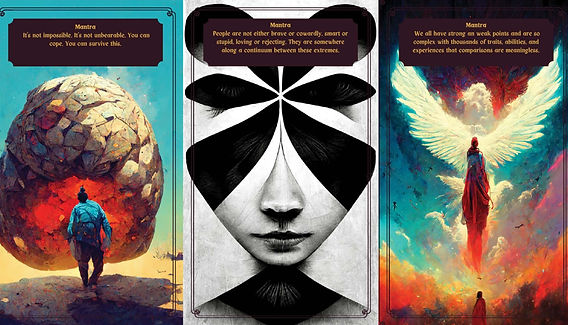MIND MONKEY
The Design
Project Development
Overview
Mind Monkey is a cooperative, turn-based dungeon crawler designed to alleviate anxiety in teenagers. On the surface, players gather items, combat monsters, and liberate characters, but beneath these engaging elements, the game incorporates techniques from Cognitive Behavioral Therapy (CBT) aimed at mitigating anxiety symptoms.
The central question we address is: How can we effectively engage teenagers to reduce anxiety, foster acceptance, and motivate them to alter the thoughts and beliefs contributing to anxiety disorders?
Mind Monkey tackles this by challenging players to collect data and assess whether the cognitive distortions of in-game characters align with observation, a method grounded in CBT principles. The game aims to enhance acceptance and motivation by subtly integrating health messages and fostering conditions conducive to a state of flow.
My Role
Duration
8 weeks
Platforms
Tabletop game
Webpage
Tools
Midjourney (2021)
Canva
Adobe Photoshop
Adobe Illustrator
Skills
Figma prototyping
Game design
Game development
HTML/CSS/JS
Project management
I spearheaded the design conception and integrated psychotherapeutic approaches into the game's features. Additionally, I crafted art assets using Midjourney, conducted user testing, and fine-tuned the game mechanics for balance.
Design Features of Mind Monkey
Addressing Anxiety-Related Thoughts:
-
Objective:
-
Change thoughts, appraisals, and beliefs that perpetuate anxiety disorders.
-
-
Rationale:
-
Cognitive restructuring, a core component of CBT, effectively treats emotional disorders by identifying biases, gathering evidence, and generating alternative explanations.
-
-
Features:
-
Cognitive Bias Identification: Players uncover and understand cognitive biases in NPCs by presenting balanced evaluations.
-
Evidence Gathering: Players collect in-game items that support or refute an NPC's cognitive bias.
-
Generating Alternatives: Players match in-game collectibles to NPCs to provide a balanced view of a cognitive bias.
-
%2012%20per%20sheet%20pg1__.jpg)
%2012%20per%20sheet%20pg51.jpg)
%2012%20per%20sheet%20pg31.jpg)
Figure 1. Players collect mantras reflecting a balanced view of the "overgeneralization" cognitive bias. Presenting these to the monkey reveals the bias's name and description, linking player actions to the concept of overgeneralization.
%2012%20per%20sheet%20pg3.jpg)
%2012%20per%20sheet%20pg1.jpg)
Figure 2. Players gather items as evidence against NPCs' cognitive biases. Here, the monkey claims "He blows up at everything." Players counter this "overgeneralization" with evidence, like a journal log, showing otherwise.


Figure 3. Players collect and match items to NPCs, offering a balanced perspective on a specific cognitive bias.
Addressing Anxiety-Related Thoughts:
-
Objective:
-
Enhance acceptance and motivation to use Mind Monkey.
-
-
Rationale:
-
Strategies like intermixing, obfuscation, and distancing mask the health message. Games often induce flow, a state of deep immersion and enjoyment.
-
-
Features:
-
Masking Health Message: Balance between game content and health message, fulfill dungeon crawler expectations, and use metaphorical representations.
-
Supporting Flow: Adjust game difficulty, set clear goals and rules, provide timely feedback, and empower players with control.
-


Figure 4. Gameplay showcases monster tokens and health items placement. The appearance rate of these items varies with the chosen difficulty level, supporting a precondition for the flow state.
%2012%20per%20sheet%20pg5.jpg)
%2012%20per%20sheet%20pg52.jpg)
Figure 5. Displayed are mantra cards tied to various cognitive distortions. Players earn points for accurately matching dialogues to cognitive distortions and presenting relevant balancing statements, drawing from Mckay et al. (2021).
Project Development
Define
We aimed to explore how games could support mental health. Our initial steps involved:
-
Reviewing literature on games for anxiety treatment.
-
Identifying unresolved issues in this domain.
-
Determining effective strategies for our solution.
Ideate
During ideation, our team:
-
Reflected on our literature findings.
-
Proposed various design approaches.
-
Assessed designs based on feasibility, passion/popularity, and research backing.
-
Ultimately, we chose a dungeon-crawler format, integrating strengths from other proposals.
Prototype
The creation of Mind Monkey entailed:
-
Designing a progressively refined physical board game.
-
Iterating mechanics based on playtest feedback.
-
Developing a web-based solution-checker.
-
Printing the final board, card, and token assets.
Copyright © 2024 Jordan Burkland. All rights reserved.








